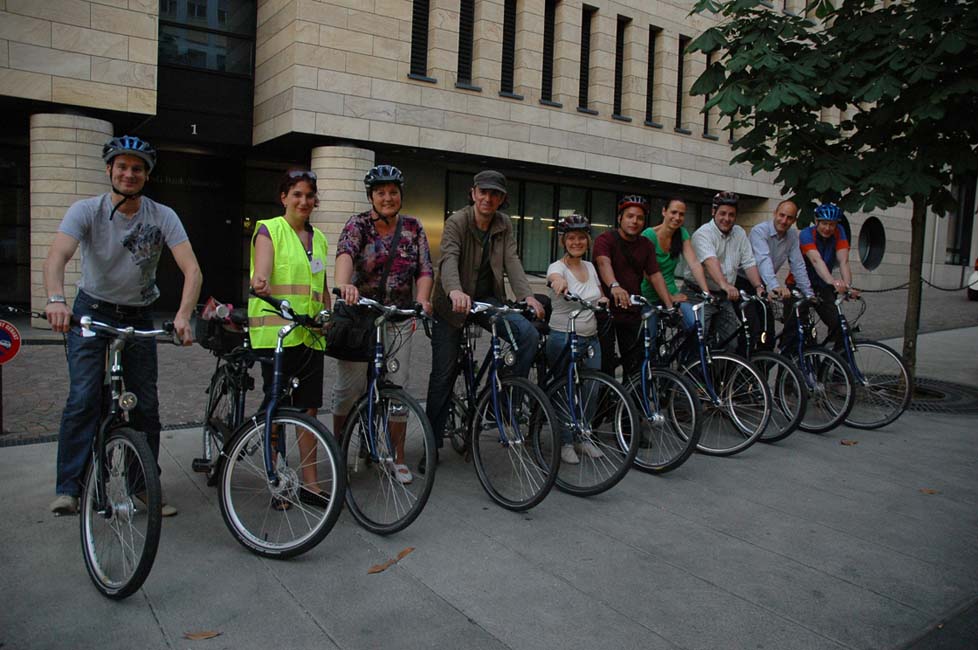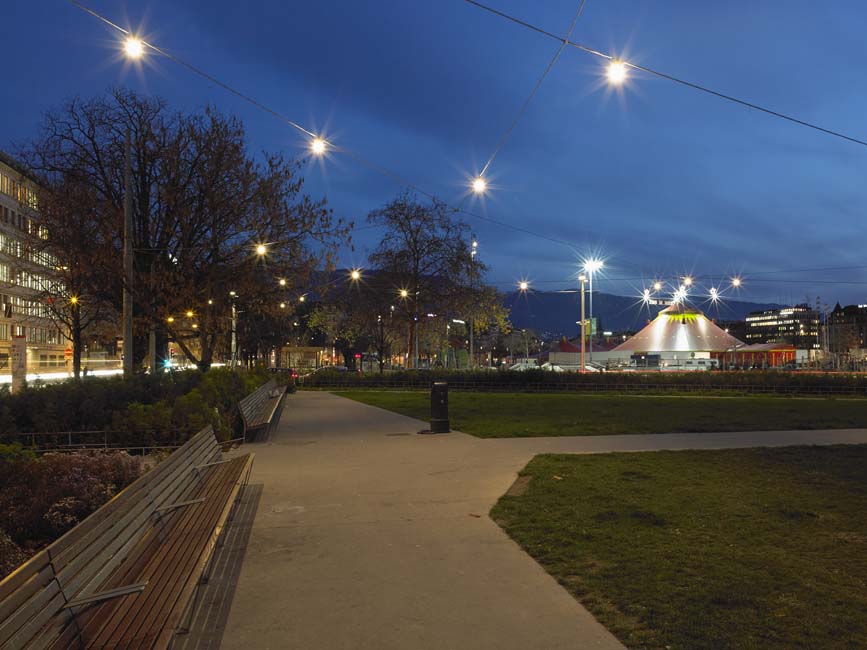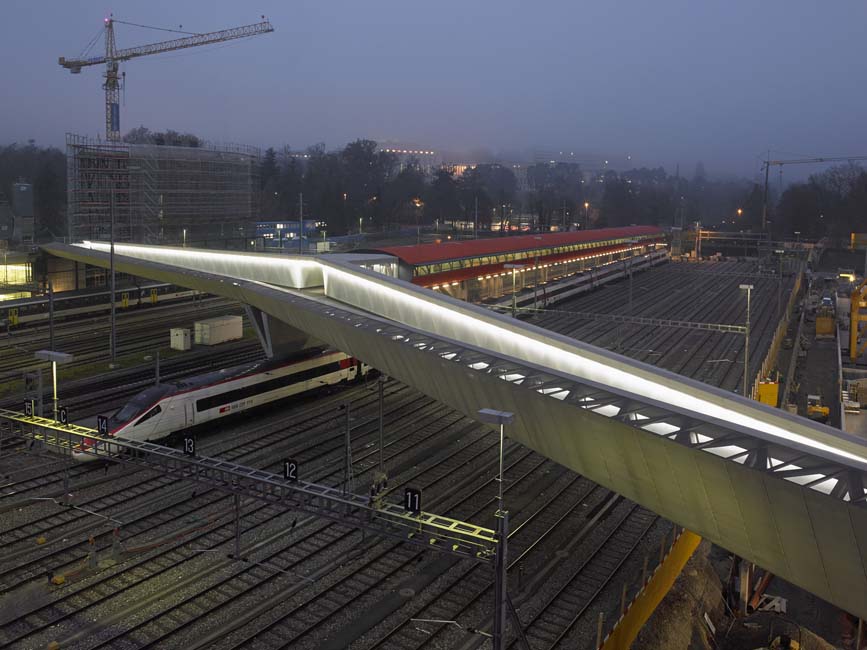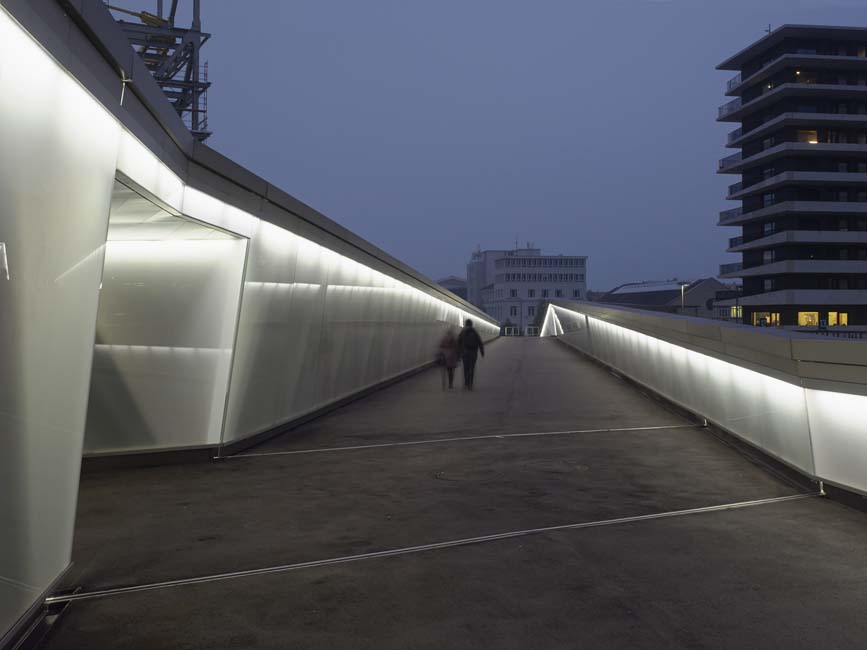Back on site: Geneva
In spring 2009, LUCI brought together over 60 urban lighting professionals in Geneva for the City under Microscope (CM).

The second most populous city in Switzerland, which had just validated its lighting master plan at the time, was keen to present its lighting policy and major projects to the cities of the LUCI network.
Conferences and site visits introduced participants to Geneva’s lighting strategy, which included a strong focus on energy efficiency and green mobility.
“The City under Microscope was an opportunity for us to exchange with colleagues from around the world and to discuss issues that we were particularly interested in, such as how lighting could support environment-friendly mobility. How could we make the transition from lighting conceived essentially for cars, as was the case until the end of the 20th century, to lighting for alternative modes of transport now developing in cities?” explains Florence Colace, Lighting Designer and Architect at the City of Geneva. “It was also the opportunity to put experiences together with other cities and draw common conclusions which help us save time and avoid certain mistakes,” she adds.

Geneva has continued working towards the goals outlined in 2009. The city has been successful in reducing the electricity consumption of urban lighting, which has decreased by 35 % in the past 5 years. At the same time, it has improved the overall quality of lighting in the urban space and moved forward in line with the lighting master plan presented in 2009. This is set to be re-assessed in 2020 within the framework of a future municipal master plan.
Lights out for mercury lamps
The city is well on its way to achieving its goal of replacing all its mercury lamps, a project that was still in its early stages when it was presented during CM Geneva in 2009. The LED lamps available at the time did not meet the city’s criteria, and as a result, 4500 mercury lamps were replaced by metal halide lamps in the first phase of this project.
The second phase is now underway and advances in LED technology have enabled the city to develop a customised LED lamp that can be retrofitted into its historical street lights. This is currently being implemented in a major square in the old city centre and will be completed this spring. “If we have positive feedback, this will be deployed in the rest of the old city centre,” says F. Colace. “More tests will be required before we do this, but it looks promising.”
“We had some problems with LEDs in the past, but in the last few years, the quality of LED lamps has greatly increased, and we are using them more and more,” explains F. Colace. “The flexibility of LEDs makes them especially pertinent with regards to temporality which is one of our guiding principles – the idea that lighting should be for the users of the city and satisfy the needs of the people living and travelling through the city.”

Light promoting green mobility
One of Geneva’s main focuses in 2009 and a principle goal of its lighting strategy was to use lighting to promote and privilege green mobility. “Green mobility is still very much a priority – we have been moving forward with the ‘Green Belt’ project that we introduced in 2009,” says F. Colace.
The Green Belt project aims to create a continuous path of 22 km designed for green mobility crossing the Geneva urban area. It will be a major pathway for all non-motorized transport (cycles, roller blades, pedestrians, etc.). In the Geneva conurbation, part of the Green Belt will be implemented alongside the ambitious CEVA (Cornavin-Eaux-Vives-Annemasse) rail link project which aims to construct a regional express railroad line between Switzerland and France with several stations.
“It is not a simple process,” explains F. Colace. “This belt runs through different areas that already have different lighting furniture and equipment, and we cannot always start a new page and budget for new lighting infrastructure, so we have to work with what we have. We are therefore working with one lighting designer who is involved in every project on the Green Belt to ensure coherent lighting.”
One of the sections of the Green Belt that has been implemented with lighting is the Passerelle de la Paix, a pedestrian and cycling bridge in the newly renovated Sécheron district. The 160 m bridge passes over the railroad and creates an essential link connecting the lake to an institutional area. The bridge is composed of perforated sheets on the outside and translucent glass on the inside. At night, the integrated long life fluorescent tube lighting behind the glass accompanies passers-by and creates soft yet effective lighting. “Its bold architecture, its dimensions and its essential function facilitating green mobility, affirm the City of Geneva’s position prioritising harmonised and sustainable urban development,” says F. Colace.

Another recently completed element of the Green Belt is the Hentsch Park – a former stadium turned into a recreational park which is lit using LED projectors installed on the masts along the pathway. These ensure that users feel comfortable as they cross the park at night as the centre of the park is not lit in order to limit light nuisance for residents nearby.
In line with its commitment to green mobility, Geneva has also completed a new lighting project on the north point of Plainpalais that uses LEDs installed on existing public transport or tram line poles to light the square in an innovative and poetic manner. This installation which seeks to resemble a starry sky, was implemented (without adding a single mast!) by Les Eclairagistes Associés, a lighting design agency from Lyon, with Geneva engineer Philippe Annen.
Award-winning projects
Two of Geneva’s lighting projects have won international awards in the past few years. In 2010 the city won the second prize of the Auroralia award for its specially customised LED lamp for the “Geneva Cordon”. While one-third of these lamps were unfortunately destroyed a few years later by a particularly violent hail storm, this resulted in a new opportunity to develop a second generation of LED lamps for the Cordon that are now more resistant and fine-tuned.
Another lighting project, dealing with the reconversion and re-illumination of the St Gervais square, won the third prize of the international city.people.light award in 2013. It successfully transformed a high traffic area into a smart, well-developed pedestrian space for citizens and visitors through the effective use of light and shadow.
And what’s in store for the future? The city is looking to experiment with off-grid lighting using alternative power sources such wind, solar, or hydro power. “Off-grid street lights, if they work correctly, could be the perfect solution for some sites where there is no electricity grid but where lighting is required,” says F. Colace.

An edited version of this article originally appeared in Cities & Lighting magazine (Issue #4, 2016).
Images (c) City of Geneva

